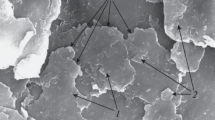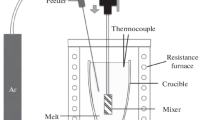Conclusions
1. Application of the linear mechanics of fracturing to composites of the boron-aluminum type is justified, since it has proven possible to determine in an experiment the value of the fracture strength which characterizes the resistance of the material to fracture.
2. The fracture strength of boron-aluminum turns out to be higher than the same characteristic of the matrix material. Boron-aluminum is a material with a high resistance to fracture, whose surface is normal to the direction of the fibers. The fracture work of boron-aluminum with a fiber content of 50% is approximately three times higher than the fracture work of the unreinforced matrix.
3. At present there is no computational model of a composite which would permit reliably estimating the value of the fracture strength and optimizing a composite for this characteristic. Such a model should intrinsically take account of the statistical characteristics of a fiber.
4. The data obtained can also be interpreted as confirmation of the existence of a scaling dependence of the strength of a composite in the case of supercritical reinforcement.
Similar content being viewed by others
Literature cited
S. T. Mileiko, N. M. Sorokin, and A. M. Tsirlin, "The strength of a boron-aluminum composite with a brittle fiber," Mekh. Polim., No. 5, 840–842 (1973).
G. R. Irwin, "Fundamentals of crack growth and fracture," in: Fracture, Vol. 3, New York (1970), p. 753.
G. C. Sih and H. Liebowitz, "Mathematical theories of brittle fracture," in: Fracture, Vol. 2, New York (1968), pp. 67–190.
A. Kelly, Strong Solids, 2nd ed., Oxford University Press (1973).
N. R. Adsit and W. E. Witzell, "Fracture toughness of aluminum-boron composites," in: National SAMPE Technical Conference, Vol. 1, No. 9, 391–398 (1969).
E. F. Olster and R. C. Jones, "Toughness mechanisms in continuous filament unidirectionally reinforced composites," in: Composite Materials: Testing and Design (Second Conference) ASTM STP497 (1972), pp. 189–205.
I. R. Hancock and G. D. Sawnson, "Toughness of filamentary boron-aluminum composites," in: Composite Materials: Testing and Design (Second Conference), ASTM STP497 (1972), pp. 299–310.
Methods of Statistical Testing of Reinforced Plastics [in Russian], Riga (1972).
S. T. Mileiko, N. M. Sorokin, and E. G. Golofast, "Elasto-plastic behavior of a composite with a metallic matrix in the case of uniaxial loading," Probl. Prochn., No. 11, 45–48 (1974).
P. E. Thomason, "The surface energy of fracture in continuous fibre-metal matrix composites," J. Mech. Phys. Solids,20, No. 3, 153–165 (1972).
J. R. Rice, in: Proceedings of the First International Conference on Fracture, Sendai (1965), pp. 283–340.
Additional information
Institute of Solid-Body Physics, Academy of Sciences of the USSR, Moscow. Translated from Mekhanika Polimerov, No. 6, pp. 1010–1017, November–December, 1976.
Rights and permissions
About this article
Cite this article
Mileiko, S.T., Sorokin, N.M. & Tsirlin, A.M. Fracture propagation in a boron-aluminum composite. Polymer Mechanics 12, 882–889 (1976). https://doi.org/10.1007/BF00856486
Received:
Issue Date:
DOI: https://doi.org/10.1007/BF00856486




